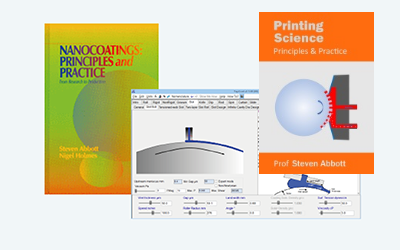Gloss Calculator
Quick Start
Gloss of a coating is very tricky to get right. That's because formulators tend to focus on just one value, roughness, which everyone measures. But it also depends strongly on surface waviness (OK, "correlation length"), which few people measure.
Because giving a single number isn't too helpful, graphs of gloss at your given roughness (with different waviness) or your given waviness (and different roughness) tell you what to expect if things change from your nominal values.
If gloss is important to you, take some time to understand the app and, importantly, learn how to get "waviness" values (λq) from your Surface Profiler, without which you only know half the story.
You can see values at any angle, but traditionally you would use 20, 60 or 85°.
Gloss Calculator
We all know that the gloss of a coating or surface depends on the roughness of the surface. Frustratingly, it seems hard to match roughness directly to gloss. This is for two reasons.
- There are numerous measures of "roughness" (See the Surface Profile Explorer) so it is not obvious which is most likely to correlate to gloss.
- Another key factor which is often not measured turns out to be crucial: the frequency, or wavelength or (scientifically) the correlation length of the roughness.
The first issue can be addressed easily. Gloss correlates strongly with Rms, the root-mean-square roughness, sometimes called Rq. Note that this is different from (and generally higher than) the common Ra value.
The effect of the wavelength of the roughness is easily explained. Suppose (absurdly) that a given measured roughness undulates over 10s of μm. At any given point the deviation of the slope of the undulation from zero is small, so the light is reflected as if the undulation were not there. So a large wavelength or small frequency gives essentially no reduction in gloss. This is because the gloss meter measures light over a small but significant range of angles of reflection, typically 2.5°, the "collection angle". You can alter this in the app if you wish, but leave at 2.5° if you don't have any other data. If, conversely, the same roughness occurs over a nm range then the slopes are very steep so the angular deviation (scattering) is large.
The basic calculation takes a roughness and a correlation length and computes the gloss value if measured at 550nmm in the middle of "white light". The graphs show:
- How changing Rms at your given correlation length changes gloss at 3 different wavelengths
- How changing correlation length at your given Rms changes gloss at those 3 wavelengths
Hopefully, by understanding how the two parameters interact you will be able to find rational strategies for decreasing Rms whilst increasing the correlation length.
One question remains. How to you get a correlation length from your surface roughness scan? In the absence of a proper correlation function analysis, just chose the λa value (See the Surface Profile Explorer), or, even better, the λq value which is based on Rms.
It is sadly the case that many surface roughness devices just output a few "standard" numbers, often neglecting anything other than Ra and Rz and being generally unaware of frequency/wavelength issues. If you are seriously interested in surface optics, you cannot work without a proper digital analysis of the data in terms of Rms, something like λq and, even better, some sort of Fourier analysis from which you can derive the proper correlation length, or the exponential fit to correlation length which is the value used in this app.
Accurate calculations of gloss are highly complex. Fortunately there is an excellent paper with a simplified equation: Ingve Simonsen, Åge G. Larsen, Erik Andreassen, Espen Ommundsen and Katrin Nord-Varhaug, Estimation of gloss from rough surface parameters, Phys. Stat. Sol. 242,2995-3000, 2005.
For light of wavelength=λ, surface of Rms=σ, with a measurement collection angle=Δ and a gloss angle=θ the gloss (assuming an incoming refractive index of 1) is given by:
`"Gloss" = exp[-16((πσ)/λ)^2cos^2θ{1-2("G(a)"/λ)sinΔcosθ}]`
G(a) is a function depending on the correlation length, a, given by:
`G(a)= (2/Δ)"atan"(Δ.a)`


